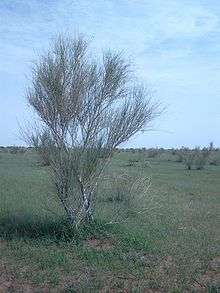Leptadenia pyrotechnica
Leptadenia pyrotechnica (Hindi: खींप; Punjabi: ਖਿੱਪ) is the botanical name of a desert herb of the family Apocynaceae. It is widespread from Senegal to India.[1] It is known as khimp in Hindi and Urdu,"Khipp" in Punjabi.[2]
| Leptadenia pyrotechnica | |
|---|---|
 | |
| Scientific classification | |
| Kingdom: | Plantae |
| Clade: | Tracheophytes |
| Clade: | Angiosperms |
| Clade: | Eudicots |
| Clade: | Asterids |
| Order: | Gentianales |
| Family: | Apocynaceae |
| Genus: | Leptadenia |
| Species: | L. pyrotechnica |
| Binomial name | |
| Leptadenia pyrotechnica | |
Being highly drought-resistant, Leptadenia pyrotechnica has played an important role in the desert afforestation programs. The herb khimp is a strong soil-binder and as such is one of the pioneer species in sand dune fixation.[3]
Uses
The plant is used in thatching huts. The pods of this shrub, known as khimpoli (खींपोळी) in Hindi, ripe in the month of March which are of medicinal value and used as vegetables. The plant fiber is used for making ropes. The plant is browsed by all stock, but especially by camels for which it is considered a good fodder.
Gallery
- Leptadenia pyrotechnica pods
- Leptadenia pyrotechnica pods
- Leptadenia pyrotechnica flower
References
- Flora of Pakistan, Leptadenia pyrotechnica (Forssk.) Decne. in Ann. Sci. Nat. Ser. 2. 9:269. 1839. Boiss., Fl. Or. 4:63.1879; Bullock in Hutch., Dalziel & Hepper, Fl. W. Trop. Afr. ed. 2.2:98. 1963; Rech. f., Fl. Iran. 73: 16.1970.
- L R Burdak (1982): Recent advances in desert afforestation, Dehradun, p.66
- L R Burdak (1982): Recent advances in desert afforestation, Dehradun, p.66